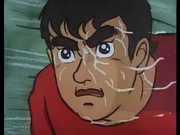Review of "Eleven Red Blood": A touching soccer anime full of blood and tears

"The Red-Blooded Eleven": A passionate story of soccer and youth■Overview of the work"Eleven Red-Blooded Vanguard" is a TV anime series that aired on Nippon Television from 1970 to 1971. It is based on a manga by Kajiwara Ikki, and aired for a total of 52 episodes from April 13, 1970 to April 5, 1971. Each episode was 30 minutes long, and it captivated many viewers as a sports anime. It was produced by Tokyo Television Animation, and the director was Yamada Ken in the early stages and Okasako Nobuhiro from the middle period onwards. Copyright belongs to Kajiwara Ikki, Sonoda Mitsuyoshi, NTV, Tokyo Television Animation, and Nippon Television. ■ StoryShingo Tamai, who entered Shinsei High School in Saitama Prefecture, was known as a problem child, but had a passion for soccer. He met former Japanese national team player Tenpei Matsuki, who was invited to Shinsei High School as a coach, and established a soccer club under his guidance. However, Shingo rebelled against Matsuki's strict instruction, so he formed a second soccer club and challenged Matsuki's soccer club. Although he was completely defeated in a match that followed the official rules, Shingo was impressed by Matsuki's passion for soccer and his coaching skills, and decided to take soccer seriously. Shingo grew up with his killer submarine shot as a weapon, and grew into a world-class player who competed against Brazil Junior as a central player in the Japan Junior League. ■Explanation"Red-Blooded Eleven" was broadcast about 20 years before the birth of the J-League, and is known as a sports anime that sparked a soccer boom among young boys. The setting of the work is the prestigious Minami-Urawa High School (formerly Urawa Municipal Minami High School), and the main character, Tamai Shingo, is modeled after Nagai Yoshikazu (formerly of Furukawa Electric). The production of the anime was a big effort, with interviews conducted at Yomiuri Soccer Club (now Tokyo Verdy) and a special program "Eve Festival" featuring the original author aired one week before the broadcast. From episode 40 onwards, the title was changed to "Soccer Guys Red-Blooded Eleven" and an original story was created about a match between Japan Junior, the team Tamai belongs to, and Brazil Junior. ■Cast
■ Main staff
■ Main Characters
■Subtitle
■ Appeal and evaluation of the work"Eleven Red-Blooded Eagles" continues to be loved by many fans as a monumental achievement in sports anime. Its appeal lies in the story of the protagonist Tamai Shingo's growth, and the drama of friendship, effort, setbacks and recovery depicted through the sport of soccer. In particular, the scene in which Tamai learns his deadly submarine shot under the tutelage of Matsuki Tenpei and goes head-to-head with his rival Misugi Jun left a strong impression on viewers. In addition, the importance of teamwork and the bonds between teammates depicted throughout the series have earned it high praise as a coming-of-age anime. In terms of the anime production, it has also been praised for its dynamic match scenes that made full use of the technology of the time, and for the way it brought out the individuality of the characters. In particular, the special moves, such as the Submarine Shoot and Screw Shoot, were visually very impactful and became a hot topic among children. In addition, the fusion of the storytelling of the original author, Ikki Kajiwara, and the direction of directors, Ken Yamada and Nobuhiro Okasako, has resulted in the entire work being completed as a consistent and passionate drama. ■Influences and historical background of the work"Eleven Red-Blooded Men" sparked a soccer boom in Japan in the 1970s. At the time, the J-League did not exist and soccer was considered a minor sport, but the broadcast of this anime made many children interested in soccer. In addition, the setting of the work, Minami-Urawa High School, and the model for the main character, Nagai Yoshikazu, were based on real people and places, which also became a hot topic and gave viewers a sense of familiarity. Furthermore, at the time of broadcast, the production team's efforts were conveyed to viewers through interviews with Yomiuri Soccer Club (now Tokyo Verdy) and a special program "Eve Festival" featuring the original author, which had the effect of raising expectations for the work. The title change and original story development from episode 40 also gave viewers a fresh surprise, further increasing the popularity of the work. ■Charm of the charactersEach character in "Eleven Red-Blooded Men" is unique and charming. The protagonist, Shingo Tamai, is depicted growing from a troubled child into a soccer player, evoking sympathy from viewers. His passionate personality and the efforts he puts into mastering his deadly submarine shot have given many children hope and dreams. Additionally, Matsuki Tenpei's strictness and kindness as a coach, as well as the story of his past glory and failure, have deeply touched viewers. His rival, Jun Misugi, is portrayed as a cool, intelligent player with a powerful screw shot and razor-sharp dribbling skills, and the showdown scene with Tamai is one of the highlights of the series. Yosuke Ohira's character as a large man who speaks in Kansai dialect also played an important role in portraying humor and friendship. The drama woven by these characters leaves a strong impression on viewers and enhances the appeal of the series. ■Music and theme songsThe theme song for "Eleven of Red Blood," "Eleven of Red Blood," and the ending theme, "Waga Tomo Tamai Shingo," were both sung by The Formates, with lyrics by the original author, Ikki Kajiwara, and music by Yasuo Osawa. These songs were important elements that heightened the excitement of the drama, and left a strong impression on viewers. The opening theme, "Eleven of Red Blood," in particular, was loved by many fans for its lyrics and melody that symbolized the theme of the work. ■Recommendations and viewing methods"Eleven Red-Blooded Eagles" is a monumental example of sports anime, and is still loved by many fans today. The drama of youth depicted through the sport of soccer and the story of the characters' growth can be enjoyed by a wide range of people, from children to adults. Also, by learning about the historical background and influences of the work, you will be able to understand and enjoy it more deeply. You can watch them by purchasing DVDs or Blu-rays, or by streaming services. Streaming services in particular allow you to watch all episodes of a work at once, making it easier to follow the flow of the story. There is also active information exchange on fan sites and social media, where you can discuss the work and share your thoughts about it, allowing you to enjoy the work even more. Conclusion"Eleven Red-Blooded Men" is a monumental sports anime that depicts a passionate story of soccer and youth. The story of the protagonist Tamai Shingo's growth, his confrontation with rivals, and the drama that depicts the importance of teamwork will deeply move viewers. Also, by learning about the historical background and influences of the work, you can understand and enjoy it more deeply. Please watch this work and experience its charm for yourself. |
<<: Review of "Tokyo Bandits": A unique anime that depicts the dark side of the city
>>: The Story of Hutch the Orphan - A thorough analysis of a touching story of adventure and growth
Recommend
Thor: The script of Thor 4 is so explosive and contains many cool things
"Thor 4", directed, written and starred...
The appeal and reviews of "The World God Only Knows: Goddess Arc": Why is it a must-see?
"The World God Only Knows: Goddess Arc"...
E3: 2 minutes of footage from the beginning of Resident Evil: Infinite Darkness
Netflix released the opening clip of the Resident...
Marvel's Ant-Man 3 "Ant-Man and the Wasp: Quantum Tide" officially starts filming
According to foreign media IGN, Marvel's new ...
The TV animation adapted from the refreshing comic "Living with Monsters" is confirmed to be broadcast next year!
Japanese manga artist noho confirmed on Twitter t...
The appeal and evaluation of Natsume's Book of Friends 5 Special Edition: Exploring the depth of the OVA version
Natsume's Book of Friends Five Special Editio...
The official plot synopsis of "New Gods: Yang Jian" reveals Yang Jian's pursuit of Chenxiang
Today (August 18), according to Sina Film, the of...
The brutal aesthetics of the rogue hero - A thorough analysis of the extreme charm and profound story
The appeal and evaluation of Hagure Yuusha no Aes...
Dragon Ball Super: Broly sets new record in 20 years, debuts in US cinemas on 16th and takes first place at box office
The latest animated film adapted from the classic...
The appeal and reviews of the movie version of "Knights of Sidonia": A fusion of epic space battles and deep human drama
Knights of Sidonia: The Movie: Humanity's Sur...
Detailed review and evaluation of SEX PISTOLS bonus footage
SEX PISTOLS Bonus Video - In-Depth Review and All...
Erlang Shen Victory Ultraman Shen Gongbao Torrekia setting picture
Recently, Ultraman China officially announced the...
Starring Ishihara Satomi! The famous Japanese manga "Cinderella Pharmacist Aoi Midori" is confirmed to be made into a live-action drama
The famous Japanese manga "Silent Cinderella...
Super Bowl preview for Thunder and Mission: Impossible 8
Marvel and Paramount each released Super Bowl tra...
"Awakening Age" and "Ideal Illuminates China" are selected into the 2021 Chinese TV Drama Anthology
According to Sina Entertainment, the State Admini...









